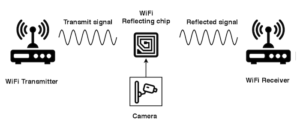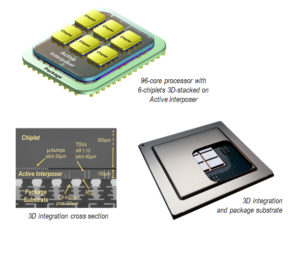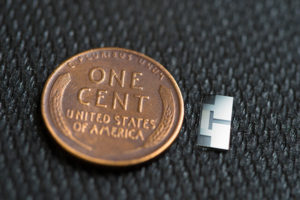
EDACafe Editorial Roberto Frazzoli
Roberto Frazzoli is a contributing editor to EDACafe. His interests as a technology journalist focus on the semiconductor ecosystem in all its aspects. Roberto started covering electronics in 1987. His weekly contribution to EDACafe started in early 2019. Low power AI and Wi-Fi for IoT; new active interposer; ultrasound in Lithium batteries; and more newsFebruary 21st, 2020 by Roberto Frazzoli
IoT edge devices take center stage this week with two significant announcements concerning low power neural processors and a UCSD research work on low power Wi-Fi, the latter presented at the recent ISSCC. Another research from UCSD promises advances in Lithium batteries; and another ISSCC paper describes a new active interposer technology boosting the capabilities of chiplet-based devices. Arm’s Neural Processing Unit Arm has recently announced the Ethos-U55, a microNPU (Neural Processing Unit) for Cortex-M, claiming a combined 480x leap in machine learning performance. The new solution targets small, power-constrained IoT and embedded devices. Ethos-U55 key features include the possibility of choosing multiple configurations to target different AI applications; an area of just 0.1mm2 to reduce energy consumption for ML workloads up to 90% compared to previous Cortex-M generations; a unified toolchain (for both Ethos-U55 and Cortex-M); native support for the most common ML network operations including CNN and RNN. Heavy compute operators – such as convolution, LSTM, RNN, pooling, activation functions, and primitive element wise functions – run directly on the Ethos-U55, while other kernels run automatically on the tightly coupled Cortex-M using CMSIS-NN. Several innovations contribute to the dramatic performance increase provided by Ethos-U55. Utilization of MAC engines on popular networks reaches 85%; operator and layer fusion, as well as layer reordering, increase performance and reduce system memory requirements up to 90%; weights and activations are fetched ahead of time using a DMA connected to system memory via AXI5 master interface; the use of an advanced, lossless model compression reduces model size up to 75% etc. Arm partners that have announced support for the new solution include Alif Semiconductor, Au-Zone, Bestechnic, Cypress, Dolby, Google, NXP, Qeexo, Shoreline IoT, and STMicroelectronics. Eta Compute’s Neural Sensor Processor Eta Compute has started shipping its ECM3532, an AI multicore processor for embedded sensor applications. Targeted at always-on image and sensor applications at the edge, the ECM3532 contains an Arm Cortex-M3 processor and a DSP for machine learning acceleration. Both cores feature the company’s patented Continuous Voltage Frequency Scaling (CVFS) technique with near threshold voltage operation, to reduce active power consumption down to hundreds of microwatts. The device includes on-chip power management which simplifies the use of CVFS with high-efficiency buck (step-down) converters that generate the required internal voltages. With the ECM3532, Eta Compute is mostly targeting applications such as sound classification, keyword spotting, object detection, people detection, people counting, activity classification, context awareness, defect detection and others. Audio AI applications can take advantage of the chip’s multiple methods of acquiring audio samples – from digital and analog MEMS microphones. Connecting IoT devices to Wi-Fi with a 28 microwatts power budget Using a technique called backscattering, an IoT device can take incoming Wi-Fi signals from a nearby device (like a smartphone) or Wi-Fi access point, modify those signals to encode its own data onto them, and then reflect the new signals onto a different Wi-Fi channel to another device or access point. In this way, the IoT device can communicate with existing Wi-Fi networks consuming just 28 microwatts. The innovation comes from the University of California San Diego and has been presented at the recent ISSCC 2020 conference in San Francisco. Transmission data rate is 2 megabits per second over a range of up to 21 meters. Thanks to a wake-up receiver, the solution can spend part of the time in sleep mode absorbing only 3 microwatts. Active interposer enables better chiplet-based devices Also presented at the ISSCC 2020, a work from French research institute CEA-Leti concerning a 96-core processor that consists of six chiplets placed on top of an active interposer. According to the researchers, conventional large-scale interposer techniques for chiplet integration – such as 2.5D passive interposers, organic substrates, and silicon bridges – have shortcomings on many aspects: long-distance chiplet-to-chiplet communications, integration of heterogeneous chiplets, integration of functions such as power management, analog IP and I/O IP. The active interposer developed by CEA-Leti, instead, integrates voltage regulators, flexible system interconnect topologies between all chiplets, energy-efficient 3D-plugs for dense high-throughput, inter-layer communication, and a memory-IO controller and the physical layer (PHY) for socket communication. The six chiplets – built in 28nm FDSOI CMOS node – are 3D-stacked in a face-to-face configuration using 20µm pitch micro-bumps onto the active interposer embedding through-silicon vias (TSVs) in a 65nm technology node. The device has been designed with a Mentor Graphics 3D CAD tool flow and implemented on a STMicroelectronics process. Ultrasound prevents “dendrites” in lithium metal batteries Lithium metal batteries have twice the capacity of today’s best lithium ion batteries but their lifespan is too short due to the development of needle-like structures called dendrites, that can grow unchecked from the anode towards the cathode causing the battery to short circuit and even catch fire. Researchers from the University of California San Diego have come up with a solution that prevents the development of dendrites: an ultrasound device integrated in the battery, propagating waves that cause the liquid electrolyte to flow – instead of standing still. The ultrasound device is made from off-the-shelf smartphone components and can be used in any battery, including commercial lithium ion batteries, to shorten charging time. Automotive FuSa solutions Samsung Foundry has successfully deployed the Synopsys TestMAX XLBIST solution on an automotive integrated circuit to provide dynamic in-system testing for critical failures, in order to meet stringent automotive functional safety (FuSa) requirements concerning automotive safety integrity levels (ASILs) for autonomous driving and advanced driver-assistance systems (ADAS). Using TestMAX XLBIST, Samsung was able to implement dynamic in-system test, which periodically executes during key phases of vehicle operation, including power-on, drive mode, and power-off. Functional safety is also being addressed by Accellera, that has recently announced the formation of a specific Working Group to create a standard that improves interoperability and traceability in the functional safety lifecycle. Upcoming events Cancellation of the Mobile World Congress in Barcelona is probably the biggest consequence of the Covid-19 outbreak on tech events so far. Fortunately, other important tech shows are confirmed: as we write (February 21), the Embedded World Conference website says that the event “takes place as planned”, from February 25 to 27. However, some important exhibitors have withdrawn from the Nuremberg, Germany, show. For live updates on the Covid-19 impact on the electronics industry, readers can check this EE Times Europe page. Other IT events planned for next week include the RSA Conference 2020, February 24 to 28 in San Francisco. |
|
|
|||||
|
|
|||||
|
|||||










